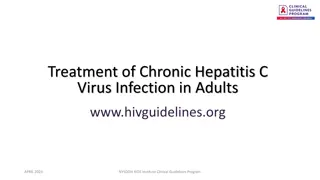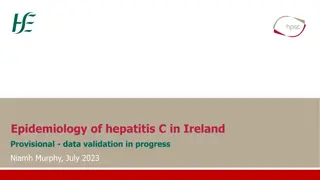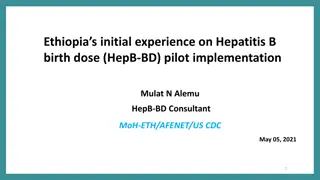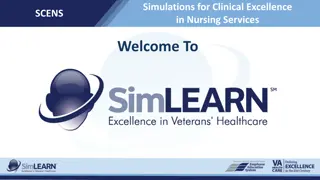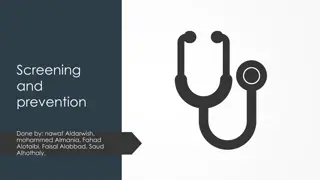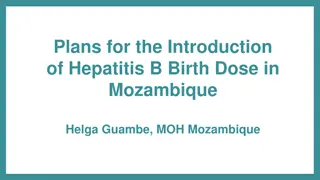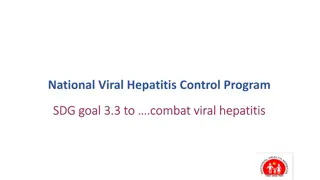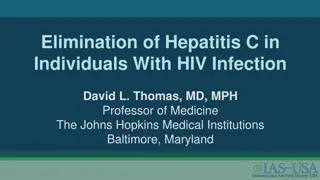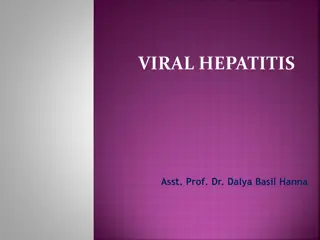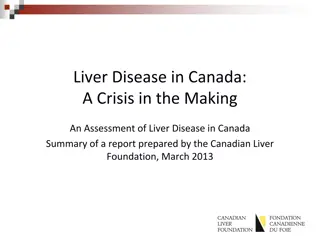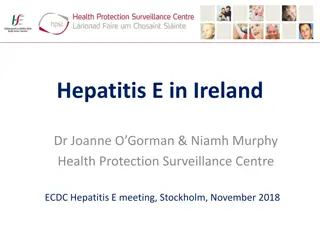Hepatitis C Screening Recommendations for Adults (2017)
The Canadian Task Force on Preventive Health Care (CTFPHC) released recommendations on Hepatitis C screening for adults in 2017. The guidelines provide an overview of screening methods, key findings, implementation considerations, and conclusions. Those at higher risk for HCV in Canada include individuals who inject drugs, have been incarcerated, or have a history of blood or organ transfusions. The guideline aims to facilitate testing for Hepatitis C in individuals at increased risk, especially with the availability of new treatments for chronic HCV.
- Hepatitis C screening
- Canadian Task Force on Preventive Health Care
- 2017 guidelines
- HCV infection
- adult screening
Uploaded on Sep 21, 2024 | 0 Views
Download Presentation

Please find below an Image/Link to download the presentation.
The content on the website is provided AS IS for your information and personal use only. It may not be sold, licensed, or shared on other websites without obtaining consent from the author. Download presentation by click this link. If you encounter any issues during the download, it is possible that the publisher has removed the file from their server.
E N D
Presentation Transcript
Recommendations on Hepatitis C Screening for Adults (2017) Canadian Task Force on Preventive Health Care (CTFPHC) Putting Prevention into Practice Canadian Task Force on Preventive Health Care Groupe d tude canadien sur les soins de sant pr ventifs
Use of Slide Deck These slides are made available publicly following the guideline s release as an educational support to assist with the dissemination, uptake and implementation of the guidelines into primary care practice Some or all of the slides in this slide deck may be used in educational contexts 2
Hepatitis C Working Group CTFPHC Members: Roland Grad (Chair) Brett Thombs Scott Klarenbach Harminder Singh Maria Bacchus Richard Birtwhistle Public Health Agency of Canada (PHAC)- Guideline: Alejandra Jaramillo Garcia (Co-Chair)* V ronique Dorais* Systematic Reviews Conducted by: - PHAC - Canadian Agency for Drugs and Technologies in Health (CADTH) Modelling Study Conducted by: - Toronto Health Economics and Technology Assessment Collaborative (Dr William Wong* et al) *non-voting member 3
Overview of Webinar Presentation Background on Hepatitis C Screening Methods of the CTFPHC Key Findings Recommendation Implementation Considerations Conclusions Questions and Answers 4
Screening for Hepatitis C BACKGROUND 5
Background Hepatitis C in Canada Those at higher risk for HCV include individuals who: 0.64% - 0.71% of Canadians have chronic hepatitis C virus (HCV) infection Inject drugs Have been incarcerated 44% of those may be undiagnosed Blood transfusion, organ transplant prior to 1992, in Canada Not all people with chronic HCV infection will develop cirrhosis or signs indicative of liver disease Have travelled or resided in endemic regions 6
Background & Purpose of Hepatitis C Screening Guideline 2017 PHAC and the College of Family Physicians of Canada (CFPC) recommend testing for hepatitis C in people at increased risk for HCV Reasons for developing this recommendation include: New treatments for chronic HCV infection Conflicting messages with U.S. guideline producers Recommendations are intended to provide clinicians and policy- makers with guidance on screening asymptomatic Canadian adults for HCV There is no organized general population screening for adults who are not otherwise at increased risk for HCV 7
Screening for Hepatitis C METHODS 8
Methods of the CTFPHC Independent panel of Clinicians and methodologists Expertise in prevention, primary care, literature synthesis, and critical appraisal Application of evidence to practice and policy Hepatitis C Working Group 6 CTFPHC members Establish research questions and analytical framework Expertise in hepatitis C (clinical experts specific to this guideline) 9
CTFPHC Review Process Internal review process involving: Guideline working group, CTFPHC, and PHAC scientific officers External review is undertaken at key stages: Protocol, systematic review, and guideline External stakeholder and peer reviewer groups: Generalist and disease specific stakeholders Federal and P/T stakeholders Academic peer reviewers CMAJ undertakes an independent peer review process to review guidelines prior to publication 10
What Evidence Does The CTFPHC Consider? Direct Evidence Screening Review (by CADTH) - Benefits and harms of screening - Cost-effectiveness - Patient preferences and values - Screening test clinical validity Indirect Evidence Treatment Review (by PHAC) - Benefits and harms of treatment Modelling Study (by Wong et al.) - Long term benefits of screening Patient focus groups: patient preferences and values related to key outcomes Stakeholder survey: Feasibility, Acceptability, Cost, and Equity (FACE) tool 11
Eligibility Criteria: Screening Review Population: Asymptomatic, non-pregnant, treatment-naive adults 18 years with unknown liver enzyme values (Exclusions: Post-transplant patients, patients with HIV, hemodialysis patients, patients with occupational exposure) Languages: English and French KQ1: Clinical Effectiveness KQ2: Harms KQ3: Cost- effectiveness KQ4: Patient Preferences KQ5: DTA Outcomes Long-term outcomes: Mortality due to HCV infection, morbidity due to HCV infection, HCC, liver transplantation, or quality of life. Intermediate outcomes: HCV transmission, virologic response, behavioural changes to improve health outcomes, or histological changes. Overdiagnosis, overtreatment, false positives, false negatives, harms of follow-up tests (including biopsy), abuse or violence, or anxiety. Cost-effectiveness analysis outcomes (e.g., ICER, ICUR, CBR) or budget impact analysis outcomes. Willingness to be screened and factors considered in decisions to be screened. DTA outcomes (e.g., sensitivity, specificity, positive predictive value, negative predictive value, likelihood ratio, diagnostic odds ratio, or AUC), detection rate, number needed to screen to detect 1 case. Study Designs RCTs, nonrandomized studies with a comparator group, or disease progression modelling studies RCTs, nonrandomized studies with or without a comparator group, or disease- progression modelling studies RCTs, economic evaluations, and economic modelling studies Descriptive studies (surveys, qualitative) and mixed-methods studies Cross-sectional 12
Eligibility Criteria: Treatment Review Population: Asymptomatic, non-pregnant, treatment-naive adults 18 years with unknown liver enzyme values (Exclusions: Post-transplant patients, patients with HIV, hemodialysis patients, patients with occupational exposure) Languages: English and French Study Designs: Randomized or non-randomized, controlled or uncontrolled, intervention studies KQ6: KQ7: Comparative Clinical Benefit of Treatments Harms Associated with Treatment Outcomes Long-term outcomes: Mortality (hepatic & all cause), Cirrhosis, Hepatocellular carcinoma, Hepatic decompensation, Need for liver transplantation, Quality of life (all scales reported) Intermediate outcomes: Reduced HCV transmission, Sustained virological response, Improvement in liver histology. Withdrawal due to adverse events, Psychological adverse events, Neutropenia, Flu-like symptoms, Anemia, rash 13
How Does the CTFPHC Grade Evidence? The GRADE System: Grading of Recommendations, Assessment, Development & Evaluation 1. Quality of Evidence 2. Strength of Recommendation Confidence that the available evidence correctly reflects the true effect Quality of supporting evidence Desirable and undesirable effects Values and preferences Resource use High, Moderate, Low, Very Low Strong, Weak 14
Screening for Hepatitis C KEY FINDINGS 15
Key Findings: Screening CADTH Systematic Review No studies of the clinical effectiveness of HCV screening in the general population or in any other higher risk or higher prevalence subgroup (e.g. birth cohort, born from 1950 to 1975 ) Wong et al. s modelling Study One time screening of 100,000 individuals not at elevated risk of HCV (0.2% prevalence) Prevent 20 cases of hepatocellular carcinoma over a lifetime horizon 40 lives saved over a lifetime horizon 16
Key Findings: Treatment The PHAC review (indirect evidence) found: Treatment with new DAA-based regimens achieved higher SVR rate than traditional regimens (Pegylated interferon) and reduced the frequency of harms Moderate quality evidence No difference in quality of life or all cause mortality at 36-72 weeks post-treatment Very low quality evidence 17
Patient Values and Preferences Patient preference findings were highly variable CADTH Review (12 observational studies): Decision to be screened for HCV Important decision-making concerns: Stigma Access to care Equal value placed on benefits and harms of screening CTFPHC-Commissioned Survey and Focus groups (15 patients): Reinforced CADTH findings Reduced mortality was perceived as a very important benefit Concerns were noted about stigma and psychological adverse events from positive screening test results 18
Resource Use Estimated costs (Canadian population): Approximately $1.5 billion to screen and treat with DAA-based regimens (assuming 50% off drug list price) Over $844 million for screening The CTFPHC places a relatively higher value on the: Very large impact that screening would have on healthcare budgets Limit on funding for health care interventions supported by better evidence 19
Feasibility, Acceptability and Equity Majority of individuals identified by screening would not qualify for treatment in Canada (asymptomatic, early stages of fibrosis, no comorbidities) A recommendation in favour of screening would increase the number of people with known HCV who cannot access treatment Unlikely to be acceptable to funders Lack of health system resources for treating all those with HCV Population-based screening 20
Screening for Hepatitis C RECOMMENDATION 21
Hepatitis C 2017 Guideline: Recommendation For practitioners on preventive health screening in a primary care setting: We recommend against screening for HCV in adults who are not at elevated risk Strong recommendation, very low quality evidence 22
Overall Quality of Evidence Overall quality of evidence supporting this recommendation is considered very low (i.e. highly uncertain), given the: Lack of direct evidence on screening for HCV in all groups of the population Many assumptions required by the modelling study (several model parameters were based on expert opinion) 23
Rationale for Direction of Recommendation Against Screening Substantial uncertainty remains about the effectiveness of screening (benefits and harms) among adults not at elevated risk in Canada 24
CTFPHC Rationale This recommendation places a relatively lower value on: 1. Very low quality indirect evidence suggesting a potentially small benefit from screening 2. Low risk of household and sexual transmission of HCV among individuals not at elevated risk 3. Low risk of transmission through blood products given routine screening of blood and organs 4. Potential risk of developing end stage liver disease and transmitting the infection despite being asymptomatic 25
CTFPHC Rationale This recommendation places a relatively higher value on: 1. Anticipated increase in harm resulting from diagnosing and treating individuals who screen positive but would have never developed HCV related disease 2. False positives and false negatives 3. Very large impact that screening and treatment would have on health care budgets 4. Potential for screening to increase inequity 5. Unknown magnitude of benefit of treatment on reducing risk of transmission 26
Rationale for Strength of Recommendation Against Screening We are confident of the potential for harm resulting from screening and treatment for HCV Screening and treating people who would have never develop HCV related disease during their lifetime Unnecessary anxiety, stigma We are confident that a recommendation to screen and treat those identified as HCV positive would require substantial resources to address access to care and treatment restrictions 27
Considerations for Re-Evaluating the CTFPHC 2017 Hep C Screening Guideline Emergence of new evidence to support screening the general population - Examining long term consequences and rates of transmission Improved access to care and treatment due to: Significant reduction in drug prices, enabling treatment for all individuals with HCV Successful roll out of a health- system wide treatment strategy NOTE: Newer drugs will not trigger an update high rates of SVR already assumed resulting from DAA treatment. 28
CTFPHC Guideline vs. Other Recommendations Recommendation aligns with guidelines from: Recommendation partlyaligns with guidelines from: Birth cohort screening recommendation based on indirect evidence US baby boomers have 4 times higher prevalence (3.25%) than Canada (0.8%) 29
Knowledge Gaps High quality, population-based prevalence data on chronic hepatitis C in Canada among the general population and in key sub-groups Trial data on the benefits and harms of screening in asymptomatic populations. Trial data on the benefits of earlier vs. later treatment (F0-F1 treatment vs. F2, F3 or F4) Evidence on the progression of chronic HCV to cirrhosis and to end-stage liver disease Evidence on the progression of disease despite SVR 30
Screening for Hepatitis C IMPLEMENTATION CONSIDERATIONS 31
Implementation Considerations More persons are diagnosed with chronic HCV in sub- groups such as the: Indigenous populations (3% prevalence) Cohort born from 1950 to 1975 (0.8% prevalence) These populations have a higher proportion of individuals at higher risk for HCV due to risk behaviours Prevalence in these groups would be similar to the lower risk population If we account for subgroups of individuals at elevated risk due to risk behaviours 32
Implementation Considerations Joint CFPC-PHAC guideline suggests HCV testing: Anyone with risk behaviours for HCV, with potential exposure to HCV, and/or with clinical clues suspicious for HCV CTFPHC supports this recommendation Some immigrants are at increased risk for HCV due to a lack of standard precautions in their country of origin E.g. medical or dental procedures with contaminated equipment Not due to injection drug use or other higher risk behaviours 33
Knowledge Translation (KT) Tools A KT tool is being developed to help clinicians understand and implement the hepatitis C screening guideline After the public release, this tool will be freely available for download in both French and English on the website: http://canadiantaskforce.ca 34
Screening for Hepatitis C CONCLUSIONS 35
Conclusions The CTFPHC recommends against screening adults not at elevated risk for HCV In Canada, the prevalence of HCV is less than 1% Direct evidence of the benefits and harms of screening for HCV is not available Not screening for HCV will focus our limited health care resources to test (and treat) individuals at elevated risk for HCV and to provide other medical interventions that are proven to be of benefit 36
More Information For more information on the details of this guideline please see: Canadian Task Force for Preventive Health Care website: http://canadiantaskforce.ca 37
Questions & Answers Thank you 38


